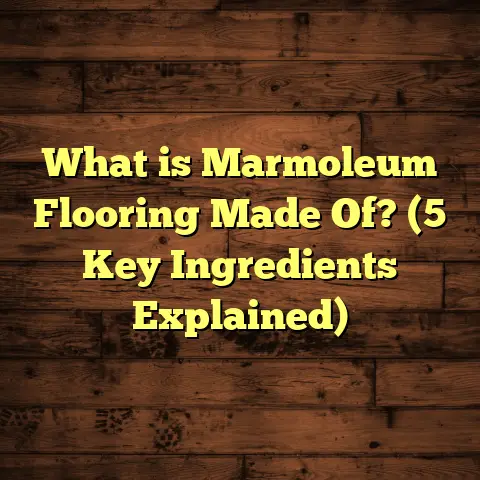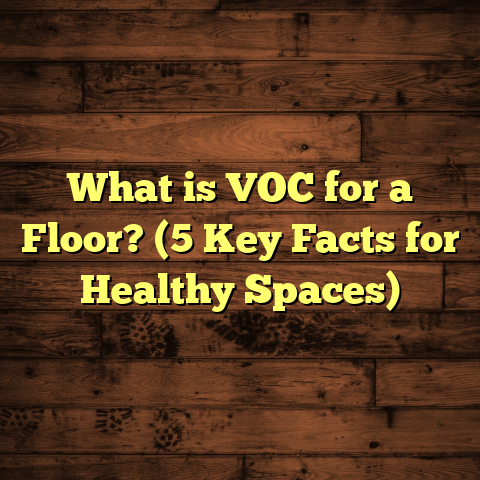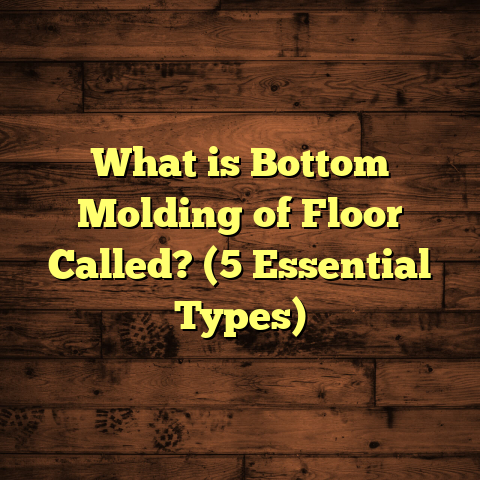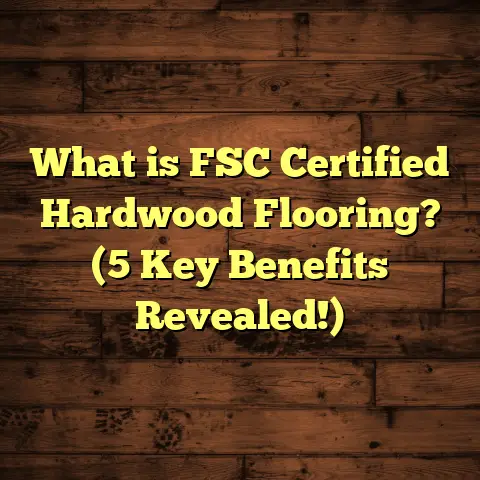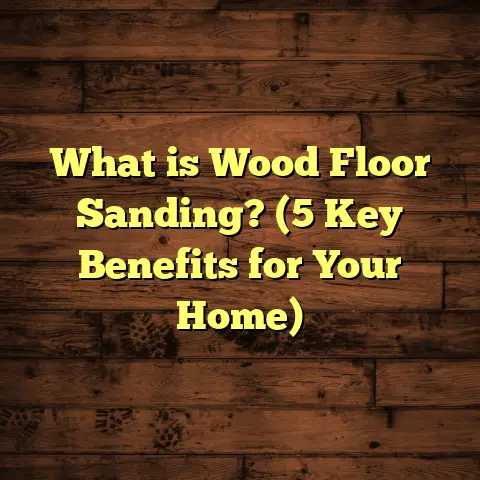What is a Hard Floor? (5 Key Features You Need to Know!)
What is a Hard Floor?
I remember when I first started working in flooring, the idea of a “hard floor” seemed straightforward — something solid underfoot like wood or tile. But over time, I realized that the term covers a wide range of materials and characteristics. It’s more than just a surface; it’s about how that surface interacts with your lifestyle, the environment, and your home’s design.
Hard floors are all around us—more common than many realize—and they come in many shapes, colors, and textures. From the shiny marble in a luxury hotel lobby to the rustic oak planks in a cozy cabin, hard floors create the foundation beneath our feet. What makes them so popular? How can you choose the right one? And what should you expect in terms of care and investment?
I want to take you through what I’ve learned over the years, sharing tips you can try yourself and stories from real projects that will help you see hard floors in a new light.
1. Durability and Longevity: How Hard Floors Stand the Test of Time
When I first worked on a commercial office renovation, the client insisted on carpet because it was “cheaper.” I convinced them to consider hardwood—even though it had a higher upfront cost. Three years later, when I visited again, their floors looked nearly as good as the day they were installed. The carpet areas? Worn out and stained.
This story is common. Hard floors offer unmatched durability compared to softer options like carpet or some laminates. Materials like solid hardwood, porcelain tile, natural stone, and even modern vinyl plank are designed to resist scratches, dents, stains, and moisture when properly installed and maintained.
Real-World Data on Longevity
- Hardwood floors can last over 100 years with proper care. This is backed by reports from the National Wood Flooring Association.
- Porcelain tile flooring typically lasts between 50-75 years, often outlasting the building itself.
- Vinyl plank flooring has improved drastically and can last 15-20 years in residential settings.
- Carpet usually needs replacing every 5-10 years, depending on traffic and maintenance.
My Experience with Durability
One project that stands out was a large family home with three active kids and two dogs. The owners wanted a floor that wouldn’t look trashed after a year or two but still felt warm and inviting. We chose engineered hardwood with a high-quality finish.
After five years, I revisited them. The floors showed very few scratches, and minor scuffs had faded with simple buffing. The family was thrilled they didn’t have to replace or cover up their floors constantly like neighbors with carpet.
Tips for Enhancing Durability
- Choose harder wood species such as oak, maple, or hickory if going for wood floors.
- For tile, opt for porcelain over ceramic for better strength.
- Ask for floors with factory-applied finishes for extra protection.
- Use area rugs in high traffic zones like entryways to reduce wear.
- Keep pet nails trimmed to prevent scratching.
2. Maintenance and Cleaning: Keeping Hard Floors Looking Great Without Stress
A question I get a lot is: “Are hard floors really easier to maintain?” The short answer is yes—but it depends on your choice of material and how you clean it.
Cleaning Tips Based on Material
- Hardwood: Regular sweeping or vacuuming prevents dirt from scratching surfaces. Mop occasionally with a damp mop; avoid soaking or harsh chemicals that can damage finishes.
- Tile: Mopping with mild detergent keeps grout clean; seal grout every few years to prevent staining.
- Vinyl: Wipe spills immediately; use gentle cleaners designed for vinyl floors.
- Stone: Needs special stone-safe cleaners; avoid acidic substances like vinegar that can etch surfaces.
Personal Story on Maintenance Challenges
I once helped a client who had installed bamboo flooring without sealing it properly. Within months, water stains appeared from spills in the kitchen area. We had to sand and reseal the floor to restore its appearance—a costly lesson on why maintenance matters.
Statistics on Cleanliness Benefits
Research shows homes with hard flooring experience fewer allergens because dust mites and pet dander don’t embed the way they do in carpets. This can lead to improved air quality and reduced allergy symptoms for sensitive individuals.
Maintenance Routine I Recommend
- Sweep or vacuum at least three times a week.
- Mop monthly or as needed with appropriate cleaner.
- Immediately wipe spills.
- Reapply sealant or finish every few years depending on wear.
- Use protective pads under furniture legs to prevent dents.
3. Style Variety: How Hard Floors Let You Express Your Taste
One of my favorite things about hard floors is the sheer variety available today. Whether you want something classic or bold, there’s an option that fits your style perfectly.
Exploring Different Looks
- Wood offers warmth and timeless appeal. You can choose plank width, color from light maple to dark walnut, and finishes from glossy to matte.
- Tile comes in endless shapes—from small mosaics to large slabs—and patterns like herringbone or chevron.
- Stone like granite or slate gives a natural, rugged texture ideal for rustic or outdoor spaces.
- Vinyl has evolved dramatically; now it mimics wood grain and stone almost perfectly at a much lower price point.
My Experience Helping Clients Choose Styles
I remember working with a couple who wanted an industrial aesthetic for their loft apartment. They picked large-format porcelain tiles that looked like concrete—super durable and modern. The finished look was stunningly different than traditional hardwood but fit their vibe perfectly.
Market Trends Backed by Data
- Hardwood remains the most popular hard flooring type in North America, making up approximately 35% of all hard floor sales.
- Vinyl plank sales have grown rapidly—up by 15% annually—because of their affordability and realism.
- Tile is favored in kitchens and bathrooms due to water resistance; about 40% of homes have tile in at least one room.
Style Tips You Can Use
- Use area rugs over hard floors to add softness without sacrificing style.
- Mix textures—for example, pair smooth hardwood with rough stone accents.
- Choose floor colors that complement your wall paint and furniture tones for a cohesive look.
- Think about lighting—natural light enhances wood’s warmth while artificial light can highlight tile patterns beautifully.
4. Installation Insights: What You Need to Know Before Laying Down Your Hard Floor
Installing hard floors isn’t always as simple as snapping boards together or laying down tiles. There are several factors that affect how well your floor performs over time.
Common Installation Challenges I’ve Encountered
- Uneven subfloors causing squeaks or gaps.
- Moisture problems leading to warping in wood floors.
- Improper adhesive application causing tiles to loosen.
- Not acclimating hardwood before installation resulting in expansion issues.
For example, in one old Victorian home renovation I worked on, the hardwood planks needed over two weeks of acclimation before installation due to seasonal humidity. Skipping this would have caused severe buckling later.
Installation Costs Breakdown
Here’s rough pricing based on my experience and industry averages:
| Flooring Type | Average Material Cost (per sq ft) | Installation Cost (per sq ft) | Total Cost (per sq ft) |
|---|---|---|---|
| Solid Hardwood | $5 – $10 | $4 – $8 | $9 – $18 |
| Engineered Hardwood | $4 – $7 | $3 – $7 | $7 – $14 |
| Porcelain Tile | $3 – $10 | $7 – $15 | $10 – $25 |
| Vinyl Plank | $2 – $5 | $1 – $3 | $3 – $8 |
Installation Tips
- Always check moisture levels in subflooring before installing wood or laminate.
- Hire professionals for tile installations unless you have experience—it requires skill to avoid lippage (uneven tile heights).
- For DIY-friendly options like vinyl planks with click-lock systems, carefully follow manufacturer instructions.
- Consider underlayment options that add sound insulation or moisture barriers.
5. Cost vs. Value: Making Smart Investments with Hard Floors
Budgeting for flooring is tricky because cheaper upfront doesn’t always mean cheaper overall.
Long-Term Cost Considerations
When clients ask me about costs, I always suggest they think beyond the sticker price:
- How long will this floor last?
- How much will maintenance cost?
- Will it add resale value to the home?
For instance, hardwood flooring typically costs more initially but often boosts home resale value by 2–5%. Tile’s durability means fewer repairs or replacements over time.
My Experience Helping Clients Budget
Once, I worked with a young couple who wanted hardwood but were worried about cost. We discussed engineered hardwood as an alternative—it looks great, lasts long (20+ years), costs less upfront, and installs faster. They saved money without sacrificing quality.
Data from Real Estate Markets
A recent study showed homes with hardwood floors sold for an average of 6% more than similar homes without them. Buyers perceive hard floors as cleaner, easier to maintain, and more upscale—even if they’re engineered rather than solid.
Actionable Budget Tips
- Get multiple quotes from installers before committing.
- Factor in additional costs like baseboards, transition strips, and removal of old flooring.
- Consider financing options if upfront cost is an issue—many suppliers offer plans.
- Prioritize quality over trendiness; classic materials tend to retain value better.
Bonus Insights: Beyond Basics — Other Hard Floor Features You Might Not Expect
Let me share some lesser-known but valuable points about hard floors that I’ve picked up:
Sound and Acoustics
Hard floors tend to reflect sound rather than absorb it, which can make rooms noisier. Adding rugs or acoustic underlayment can help manage this without losing the benefits of easy cleaning.
Environmental Impact
Many hard floor materials are more eco-friendly than carpet because they don’t trap dust or off-gas VOCs (volatile organic compounds). Bamboo flooring is especially popular among eco-conscious homeowners because it’s renewable and fast-growing.
Repairability
I’ve repaired many hardwood floors with minor sanding instead of full replacement—something you can’t do with carpet or vinyl once damaged beyond repair.
Final Thoughts From My Flooring Journey
Hard floors aren’t just surfaces—they’re investments in comfort, style, health, and home value. They require some upfront planning but reward you with lasting beauty and ease of care.
If you’re considering switching from carpet or upgrading your current floors, think about what features matter most based on your lifestyle:
- Want something tough and long-lasting? Go hardwood or porcelain tile.
- Need easy cleaning? Vinyl plank or tile might be better.
- Love variety in design? Explore textures and finishes across materials.
Feel free to reach out anytime if you want help choosing or installing hard floors—I’m always happy to share what works best based on real-world experience!

